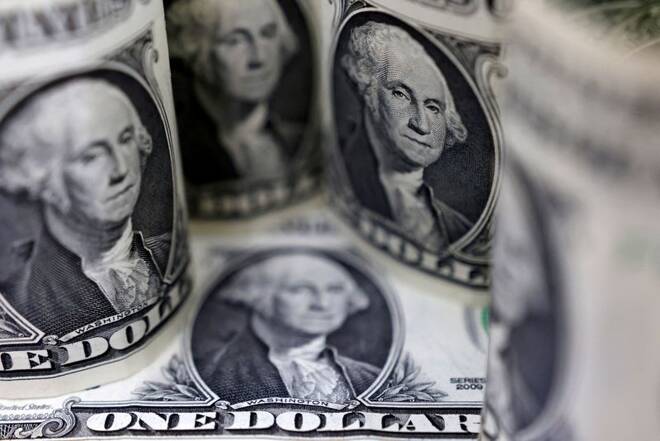Advertisement
Advertisement
Dollar at 7-month low vs euro on slower Fed rate hike expectations
By:
SINGAPORE (Reuters) - The U.S. dollar was steady on Monday as investors digested a clutch of economic data released last week that stoked hopes of the Federal Reserve slowing the pace of its interest rate hikes.
By John McCrank
NEW YORK (Reuters) -The U.S. dollar on Monday slid to a seven-month low against the euro as traders bet recent economic data would prompt the Federal Reserve to slow the pace of interest rate hikes, while riskier currencies benefited from China reopening its borders.
The euro was up 0.96% at $1.0747 at 2:50 p.m. EST (1950 GMT), its highest level versus the greenback since June 9, adding to Friday’s 1.17% increase.
Sterling surged 0.87% to $1.21975 against the dollar, building on Friday’s 1.5% rally, while the Swiss franc jumped 0.82% to $0.92, its strongest since early March.
The moves continued the trend lower for the dollar, which in the final three months of 2022 posted its biggest quarterly loss in 12 years. That was driven mainly by investors’ belief that the Fed will not raise rates beyond 5%, from its current range of 4.25%-4.50%, as inflation and growth cool.
“There are a lot of people looking at the Fed funds futures and it seems we might get one rate hike in February and then possibly a rate cut at the end of the year and that’s, I think, paving the way for a lot of people to bet against the dollar,” said Edward Moya, senior markets analyst at Oanda.
Fed fund futures show investors believe the most likely outcome for the Fed’s February meeting is for a 25 basis- point increase.
“The consensus call is that at the end of the year the dollar will be much lower and a lot of people are trying to get ahead of that trade,” said Moya.
The Fed raised interest rates by 50 basis points last month after delivering four consecutive 75 basis-point hikes last year, but said it was likely to keep interest rates higher for longer to tame inflation.
Two separate reports on Friday painted a picture of an economy that is growing and adding jobs, but where overall activity is tilting into recession territory, prompting traders to sell the dollar against a range of currencies.
Friday’s monthly employment report showed a bigger-than-expected increase in the number of workers and a slowing in wage growth – welcome news for the U.S. central bank.
A report from the Institute for Supply Management showed activity in the service sector contracted for the first time in 2-1/2 years in December.
The dollar index was at a 7-month low, last down 0.81% at 103.033. The index, which measures the greenback against six major currencies, tumbled 1.15% on Friday as investors shifted into riskier assets.
With U.S. inflation data due on Thursday, the outlook for price pressures will be front-and-center for investors.
“The expectation with this week’s Consumer Price Index is for further easing of inflation pressures,” said Greg McBride, chief financial analyst at Bankrate. “Anything less than broad-based improvement will rattle investors’ nerves and keep the Fed active.”
Elsewhere, China continued to dismantle much of its strict zero-COVID rules around movement as it reopened its borders.
Optimism about a swift economic recovery sent China’s offshore yuan to five-month highs against the dollar on Monday.
The Australian dollar rose by 0.8% to $0.69305, hitting its highest level against the U.S. currency since Aug. 30, while the kiwi was last up 0.45% at $0.6378.
(Reporting by John McCrank in New York and Amanda Cooper in LondonEditing by Conor Humphries and Matthew Lewis)
About the Author
Reuterscontributor
Reuters, the news and media division of Thomson Reuters, is the world’s largest international multimedia news provider reaching more than one billion people every day. Reuters provides trusted business, financial, national, and international news to professionals via Thomson Reuters desktops, the world's media organizations, and directly to consumers at Reuters.com and via Reuters TV. Learn more about Thomson Reuters products:
Advertisement
